QMJSCW
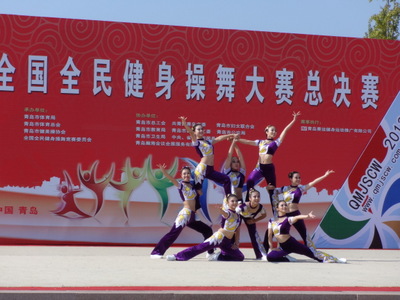
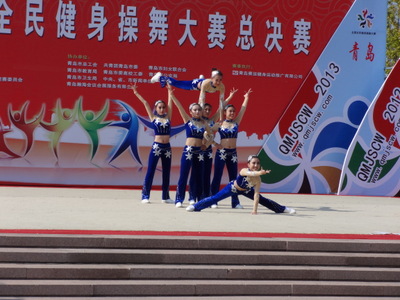 So much for Mao jackets. We had expected uniformity and somberness of dress and a preponderance of traditional Chinese music, but we were disabused of these notions promptly. When we arrived and checked into the hotel, the muzak in the lobby was playing "Silent Night," followed by "Greensleeves," then segued into a mixture of light classical and movie themes, all instrumental. The tape was quite long, but we heard the whole thing several times over in the course of the week.
So much for Mao jackets. We had expected uniformity and somberness of dress and a preponderance of traditional Chinese music, but we were disabused of these notions promptly. When we arrived and checked into the hotel, the muzak in the lobby was playing "Silent Night," followed by "Greensleeves," then segued into a mixture of light classical and movie themes, all instrumental. The tape was quite long, but we heard the whole thing several times over in the course of the week.
What we had seen from the windows at breakfast was warm-up and practice. By the time we got down there, the competition had begun. Groups of dancers, ranging in age from maybe 5 to late teens, performed highly athletic synchronized dancing strongly reminiscent of the FSU Golden Girls. Each group would line up at the edge of the stage while it was introduced, its captain would step forward and wave as his or her name was announced, then the music would start, the group would snap eyes-left to the reviewing stand, slap on identical wide smiles, and march smartly to the center of the stage to form its opening tableau.
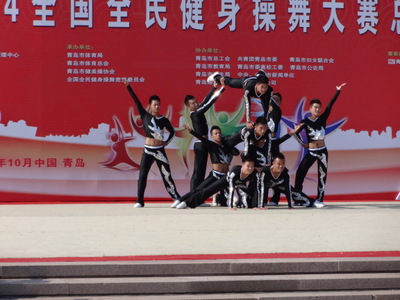
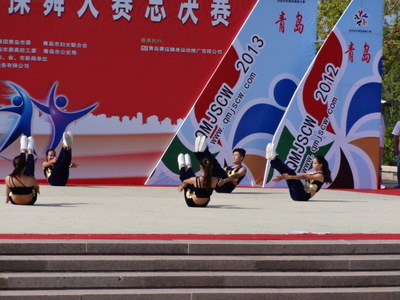 Some groups of dancers were all girls or all boys, but many were mixed; in the latter case, girls always outnumbered the guys. All were dressed in brightly colored lycra and spandex, sequins and glitter, bare midriffs, and were heavily made up (even the boys), with more glitter on their faces. I started out, as we watched the older groups, thinking that the dance routines differed from those of the Golden Girls in involving less suggestive moves, but then the eight-year-olds got up and, whoa, their routines included the bumps and grinds! We had clearly arrived during the "compulsory figures" portion of the event, because all the groups (within each age class) performed to the same music (a loud, throbbing rock instrumental) and included the same (apparently required) routines, some of them requiring really good balance and real upper-body strength! The groups were apparently allowed to choose their own opening and closing tableaux and transitions among required routines.
Some groups of dancers were all girls or all boys, but many were mixed; in the latter case, girls always outnumbered the guys. All were dressed in brightly colored lycra and spandex, sequins and glitter, bare midriffs, and were heavily made up (even the boys), with more glitter on their faces. I started out, as we watched the older groups, thinking that the dance routines differed from those of the Golden Girls in involving less suggestive moves, but then the eight-year-olds got up and, whoa, their routines included the bumps and grinds! We had clearly arrived during the "compulsory figures" portion of the event, because all the groups (within each age class) performed to the same music (a loud, throbbing rock instrumental) and included the same (apparently required) routines, some of them requiring really good balance and real upper-body strength! The groups were apparently allowed to choose their own opening and closing tableaux and transitions among required routines.
One of the required routines is shown at the right. From reclining positions, the dancers rose into position with their knees bent, feet on the ground, and backs at the angle you see here. They they extended their arms on either side of their knees, then, balanced on their tushes, raised their feet until their legs were straight, holding each step for several seconds, all without rocking or tipping, and all at precisely the same angles to the ground. Not easy! They were already on the ground because they had just finished another required series of moves. In push-up position, resting face down on their toes and hands, with extended arms, they lowered themselves toward the ground until level (at the height their toes held them from the ground), came back up, walked their toes apart (one step in each direction), dipped to level again, came back up, walked their toes back together, then rolled first to one side and then to the other, so that they rested on the sides of their feet and one hand, arm extended, with the other arm pointing upward into the air (and, of course, the two arms precisely colinear and precisely at right angles to the body).
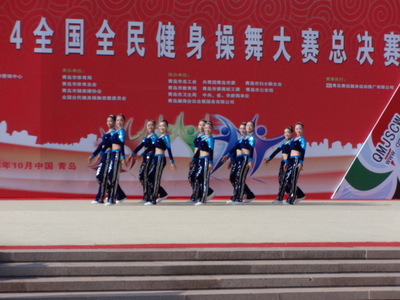
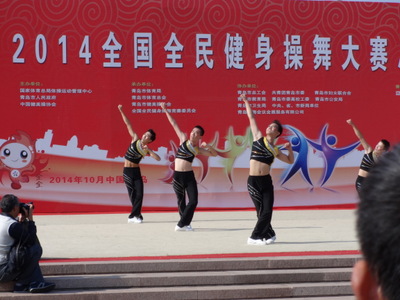 We never figured out what all this was apropos of. Was it associated with team sports, like cheerleaders, pom squads, and whatever you call what the Golden Girls do? Were the teams sponsored by schools? municipalities? clubs of some kind? orphanages?! We could pick out city names from some of the introductions, and they all seemed to be relatively nearby, so I assume these were regionals. The groups were all accompanied by a couple of the usual parental-unit types, guarding the heap of backpacks and whatnot, just as they would be in the U.S. Friends in Tallahassee to whom I described some of the moves recoignized the one where they balanced on their tushes from Pilates class, so maybe it was some sort of Pilates competition.
We never figured out what all this was apropos of. Was it associated with team sports, like cheerleaders, pom squads, and whatever you call what the Golden Girls do? Were the teams sponsored by schools? municipalities? clubs of some kind? orphanages?! We could pick out city names from some of the introductions, and they all seemed to be relatively nearby, so I assume these were regionals. The groups were all accompanied by a couple of the usual parental-unit types, guarding the heap of backpacks and whatnot, just as they would be in the U.S. Friends in Tallahassee to whom I described some of the moves recoignized the one where they balanced on their tushes from Pilates class, so maybe it was some sort of Pilates competition.
The only English on any of the signage was the initials and URL you can see on the banners in the background of some of the photos and a small logo in one corner saying something about fitness equipment. The website is all in Chinese, but it includes a map of China with stars all over it, presumably the locations of other regional competitions.
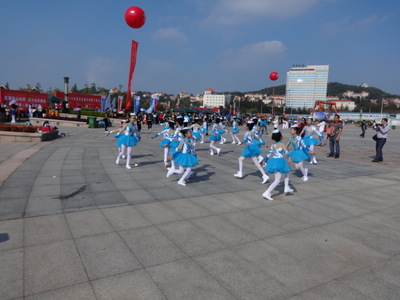
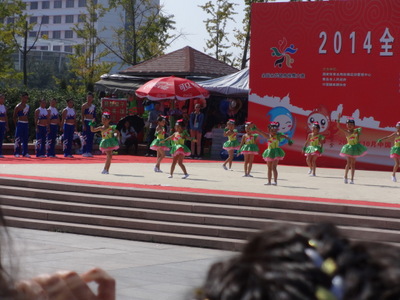 Here are a couple of the younger groups, both all girls. Their outfits tended much less to the sleek and much more to the frilly. One group even had two-foot skinny feathers sticking straight up from their heads.
Here are a couple of the younger groups, both all girls. Their outfits tended much less to the sleek and much more to the frilly. One group even had two-foot skinny feathers sticking straight up from their heads.
When we came back the next day, we didn't stay as long. The same groups were back but doing their free-style routines, which to my surprise were less interesting than the compulsory figures. They chose their own music, all of it western (i.e., non-Asian) style, some of it with English lyrics. Many also used props. One all-girl group danced with identical light-blue stuffed pokemon dolls.
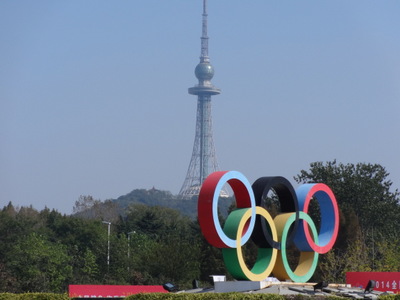
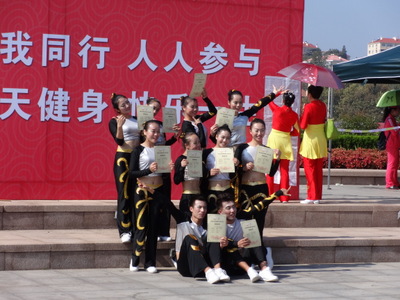 Finally, here's a shot of the Olympic rings in the center of the plaza, with, in the background, a tower on a nearby hill that I think you can go up in. We never had the chance to check it out.
Finally, here's a shot of the Olympic rings in the center of the plaza, with, in the background, a tower on a nearby hill that I think you can go up in. We never had the chance to check it out.
On the right is a co-ed group posing for photos with their prize certificates. The two ladies in red and yellow in the background are part of the only older group we saw. We never got to watch them perform.
When, later in the week, I asked one of the grad students manning the conference registration desk about the
whole synchronized dance phenomenon, she looked at me as though I was from the moon. Young people? Dancing? Never. In China, only old people dance. Perhaps I called it the wrong thing—maybe this kind of thing is considered callisthenics or gymnastics or some such.
Sex Ratio
Because of China's one-child-per-couple policy and all the horror stories you hear about orphanages full of abandoned baby girls, we had expected the sex ratio among young people to be visibly skewed, but that's not what we found.
Girls outnumbered boys at the QMJSCW, we saw families with female as well as male toddlers, and teenage girls roamed the streets in packs, just as they do in the U.S. The vast majority of desk clerks, wait staff, hotel maids, and other low-level employees were young women (we didn't see much in the way of high-level employees), and at least half of the volunteers manning the desks, projectors, and whatnot at the conference—almost all graduate students at one or another of the city's marine-science institutions—were female.
We did notice some disparities that surprised us. David remarked, when we dined at the Huang Hai, that the young women employed at the Huiquan Dynasty must have to pass a beauty contest, because they were all noticeably prettier than those at the Huang Hai. Once he'd pointed it out, I had to agree he was right. Discrimination on looks wouldn't be legal in the U.S., but I don't know the rules here. I also noticed, once I started looking, that the young women at the Huiquan Dynasty were noticeably happier and more cheerful. Not only did they present that appearance to us, but I saw them joking and giggling among themselves when no guests were nearby (which the waitresses at the Huang Hai didn't). Were they happier because they were paid and treated better than those at the other hotel? Or did our hotel select for cheerful employees as well as pretty ones?
Was the sex ratio not skewed because the importance of having a son is less in an urban than in an agrarian environment? Or the problem of getting rid of an unwanted girl more difficult? Or did these establishments draw their staff from orphanages? If the latter, then those orphanages are doing a better job or raising happy well-adjusted people than I would have guessed.
Any readers out there have any answers to these questions?
previous entry
List of Entries
next entry

 So much for Mao jackets. We had expected uniformity and somberness of dress and a preponderance of traditional Chinese music, but we were disabused of these notions promptly. When we arrived and checked into the hotel, the muzak in the lobby was playing "Silent Night," followed by "Greensleeves," then segued into a mixture of light classical and movie themes, all instrumental. The tape was quite long, but we heard the whole thing several times over in the course of the week.
So much for Mao jackets. We had expected uniformity and somberness of dress and a preponderance of traditional Chinese music, but we were disabused of these notions promptly. When we arrived and checked into the hotel, the muzak in the lobby was playing "Silent Night," followed by "Greensleeves," then segued into a mixture of light classical and movie themes, all instrumental. The tape was quite long, but we heard the whole thing several times over in the course of the week.
 Some groups of dancers were all girls or all boys, but many were mixed; in the latter case, girls always outnumbered the guys. All were dressed in brightly colored lycra and spandex, sequins and glitter, bare midriffs, and were heavily made up (even the boys), with more glitter on their faces. I started out, as we watched the older groups, thinking that the dance routines differed from those of the Golden Girls in involving less suggestive moves, but then the eight-year-olds got up and, whoa, their routines included the bumps and grinds! We had clearly arrived during the "compulsory figures" portion of the event, because all the groups (within each age class) performed to the same music (a loud, throbbing rock instrumental) and included the same (apparently required) routines, some of them requiring really good balance and real upper-body strength! The groups were apparently allowed to choose their own opening and closing tableaux and transitions among required routines.
Some groups of dancers were all girls or all boys, but many were mixed; in the latter case, girls always outnumbered the guys. All were dressed in brightly colored lycra and spandex, sequins and glitter, bare midriffs, and were heavily made up (even the boys), with more glitter on their faces. I started out, as we watched the older groups, thinking that the dance routines differed from those of the Golden Girls in involving less suggestive moves, but then the eight-year-olds got up and, whoa, their routines included the bumps and grinds! We had clearly arrived during the "compulsory figures" portion of the event, because all the groups (within each age class) performed to the same music (a loud, throbbing rock instrumental) and included the same (apparently required) routines, some of them requiring really good balance and real upper-body strength! The groups were apparently allowed to choose their own opening and closing tableaux and transitions among required routines.
 We never figured out what all this was apropos of. Was it associated with team sports, like cheerleaders, pom squads, and whatever you call what the Golden Girls do? Were the teams sponsored by schools? municipalities? clubs of some kind? orphanages?! We could pick out city names from some of the introductions, and they all seemed to be relatively nearby, so I assume these were regionals. The groups were all accompanied by a couple of the usual parental-unit types, guarding the heap of backpacks and whatnot, just as they would be in the U.S. Friends in Tallahassee to whom I described some of the moves recoignized the one where they balanced on their tushes from Pilates class, so maybe it was some sort of Pilates competition.
We never figured out what all this was apropos of. Was it associated with team sports, like cheerleaders, pom squads, and whatever you call what the Golden Girls do? Were the teams sponsored by schools? municipalities? clubs of some kind? orphanages?! We could pick out city names from some of the introductions, and they all seemed to be relatively nearby, so I assume these were regionals. The groups were all accompanied by a couple of the usual parental-unit types, guarding the heap of backpacks and whatnot, just as they would be in the U.S. Friends in Tallahassee to whom I described some of the moves recoignized the one where they balanced on their tushes from Pilates class, so maybe it was some sort of Pilates competition.
 Here are a couple of the younger groups, both all girls. Their outfits tended much less to the sleek and much more to the frilly. One group even had two-foot skinny feathers sticking straight up from their heads.
Here are a couple of the younger groups, both all girls. Their outfits tended much less to the sleek and much more to the frilly. One group even had two-foot skinny feathers sticking straight up from their heads.
 Finally, here's a shot of the Olympic rings in the center of the plaza, with, in the background, a tower on a nearby hill that I think you can go up in. We never had the chance to check it out.
Finally, here's a shot of the Olympic rings in the center of the plaza, with, in the background, a tower on a nearby hill that I think you can go up in. We never had the chance to check it out.